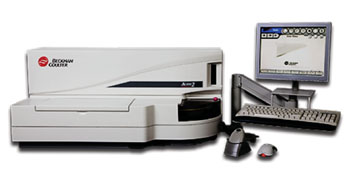Serum Bone Alkaline Phosphatase Activity Methods Compared
By LabMedica International staff writers
Posted on 02 Aug 2016
Serum bone alkaline phosphatase is a marker of bone formation and metabolism, however, existing methods for measuring it have their limitations and their accuracy has not been determined.Posted on 02 Aug 2016
Alkaline phosphatase (ALP) isozymes have been used as biomarkers for liver and bone disease in the clinic and the measurement of ALP isozymes activity in serum has a high clinical value in the differential diagnosis and analysis of some diseases.

Image: The Access 2 immunoassay system (Photo courtesy of Beckman Coulter).
Scientists at the Hamamatsu University School of Medicine (Japan) measured serum bone ALP activity in 127 patients with liver disease using two methods, electrophoresis and chemiluminescent enzyme immunoassay (CLEIA). Of these, 52 patients had primary biliary cirrhosis, eight were affected by cholestatic cirrhosis, 13 had cholestatic hepatic disorder, and the rest were diagnosed with other liver diseases.
The team used for the analysis of ALP isozymes, electrophoresis agarose gels Quick Gel ALP with Quick ALP reagent (Helena Labs, Beaumont, TX, USA). In order to separate liver- and bone-type ALP completely, samples were pretreated with neuraminidase. In addition, samples were pretreated with protease to separate bone- and intestinal-type. Bands were scanned by densitometry at a wavelength of 570 nm. ALP isozyme activity was expressed in U/L and as a percentage of total ALP activity.
A one-step immunoenzymatic assay was used in this study. An automated chemiluminescence enzyme immunoassay device, known as an Access Immunoanalyzer (Beckman Coulter, Brea, CA, USA), and a special bone-type ALP (BAP) kit (also from Beckman Coulter) were used. Basic biochemical examinations of serum samples, using a chemistry analyzer (Labospect 008; Hitachi Ltd, Tokyo, Japan), were undertaken.
The investigators found that when ALP3 isozyme values were high ((%; bone-type isozyme activity as a percentage of total ALP activity), the two methods showed good correlation. However, with a decrease in ALP3 percentage levels, the correlation coefficient (R) also decreased. Starting with ALP3 (%) of less than 23%, R values markedly decreased to less than 0.5. Five outliers displayed low ALP3 (%) activity levels. Furthermore, in regard to genders, there were significant differences in total cholesterol (TC), γ-glutamyltransferase (γ-GTP), ALP and ALP3 (%) levels.
The authors concluded that the study suggests that for whole and bone-type ALP predominating (ALP2% equal to or less than ALP3%) samples, electrophoresis and CLEIA methods show good correlation. However, the accuracy of electrophoresis needs to be evaluated with further when patient samples under certain conditions. The study was published on June 9, 2016, in the journal Clinica Chimica Acta.
Related Links:
Hamamatsu University School of Medicine
Helena Labs
Beckman Coulter
Hitachi














